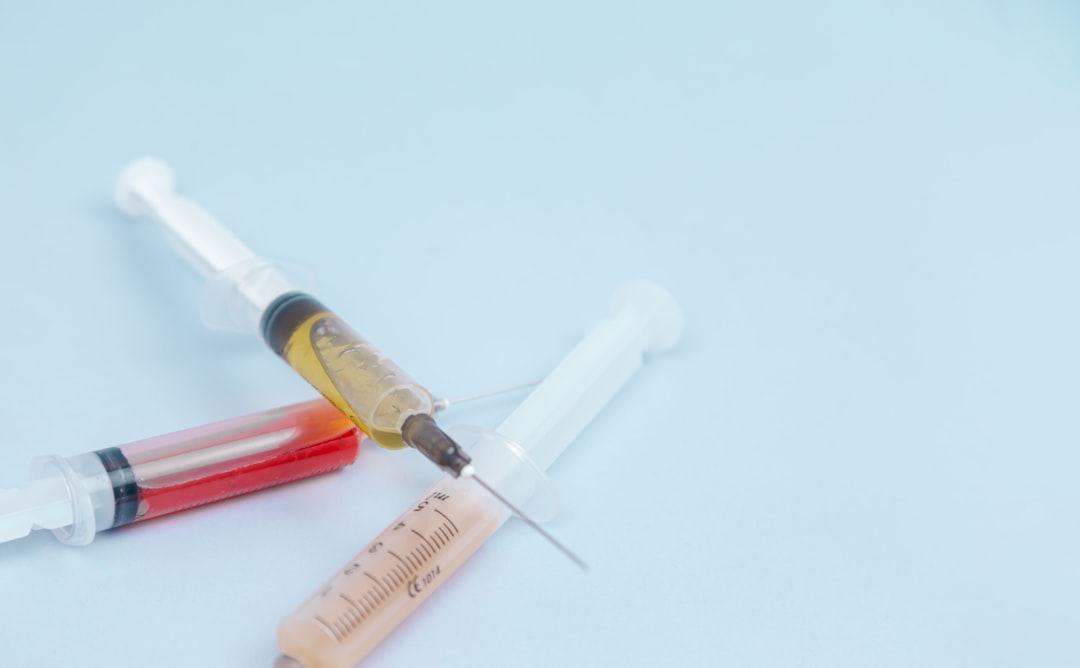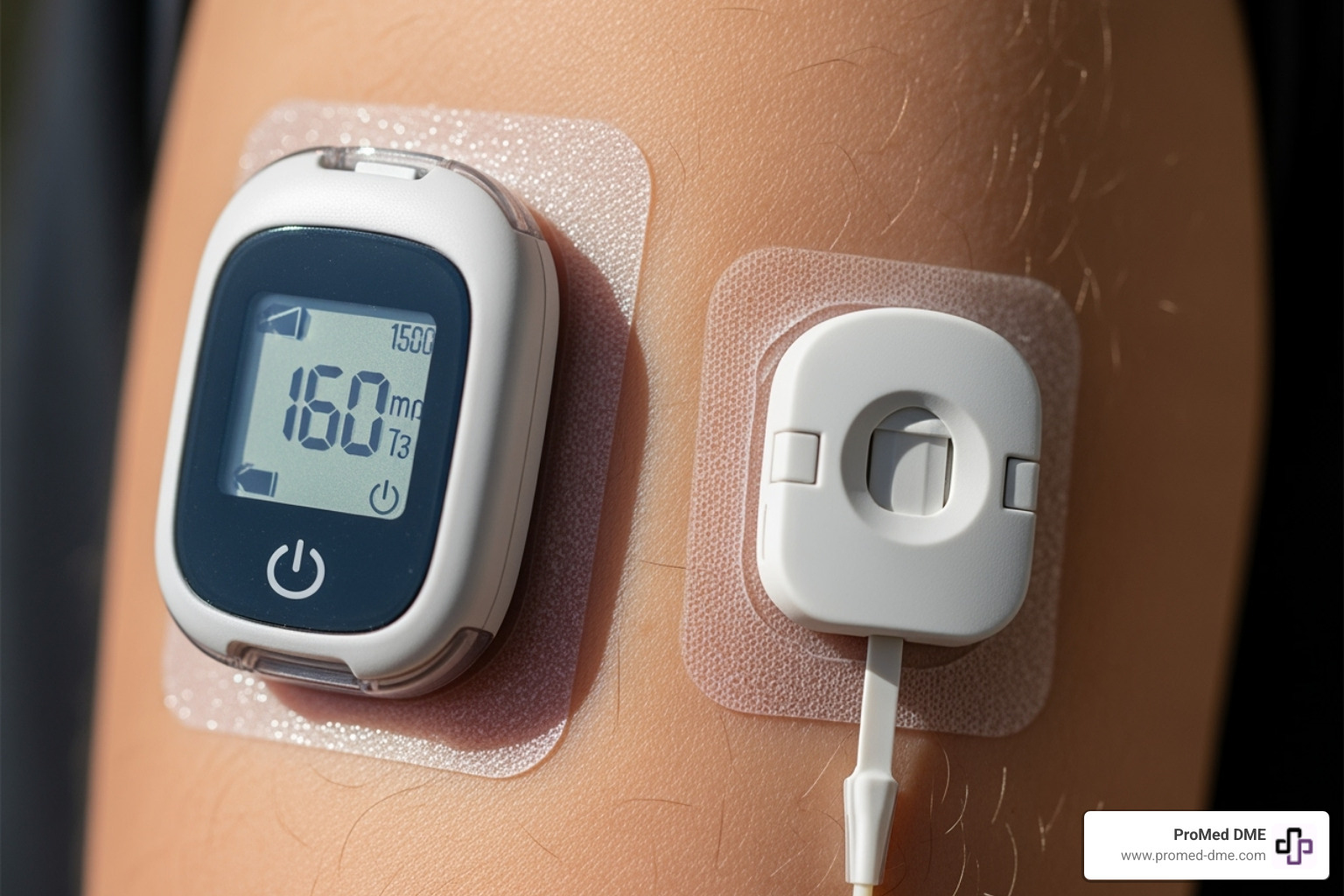The Ultimate Guide to CGM Benefits

Introduction to CGM
Are you struggling with the constant prick of a glucometer to keep track of your blood sugar levels? The pain, inconvenience, and inaccuracy of traditional glucose meters can add plenty of frustration to the already demanding life of a person with diabetes. Especially for our valued customers in their golden years, we at ProMed DME understand that effectively managing your health shouldn't be a constant hassle. Here's where Continuous Glucose Monitors (CGM) can make a considerable difference, offering a less intrusive, more accurate, and convenient way to track glucose levels.
What is CGM?
CGM, or Continuous Glucose Monitoring, is an advanced technology that monitors your blood glucose (or blood sugar) levels throughout the day and night. Just as its name suggests, this monitoring is continuous, offering real-time insights into your blood sugar levels. With this data, you can make more informed decisions about your diet, physical activity, and medication use, all to keep your glucose levels stable and stave off potential health complications.
How does CGM work?
A CGM system consists of three parts: a tiny sensor, a transmitter, and a receiver (often a smartphone or a dedicated device). The sensor resides under your skin and estimates glucose levels in the bodily fluid. This information is then sent to the receiver via the transmitter, keeping you updated with your glucose levels at any given moment.
CGM provides a more comprehensive view of how your blood glucose changes over time, allowing you to spot trends and patterns. Whether you need insulin therapy to handle type 1 diabetes, type 2 diabetes, or any other kind of diabetes, a CGM could be beneficial.
Here's a quick snapshot of CGM components:
- Sensor: This is placed under your skin and measures glucose levels at regular intervals.
- Transmitter: Attached to the sensor, it wirelessly sends the glucose data to the receiver.
- Receiver: This could be a specialized device, your smartphone, or an insulin pump where you can view and record your glucose levels.
Stay tuned with us to delve deeper into the benefits of CGM, its working, associated costs, and how we at ProMed DME are committed to helping you on your journey with CGM.
Understanding the Benefits of CGM
Using a Continuous Glucose Monitor (CGM) provides several benefits that can significantly improve your diabetes management. Let's delve into these benefits to give you a better understanding of how a CGM system can make a difference in your life.
Real-time Glucose Monitoring
One of the main advantages of using a CGM is the ability to monitor glucose levels in real-time. This means you can see your current blood sugar levels and how they're trending at any moment. This continuous feedback allows you to react quickly to fluctuations in your glucose levels, helping you to avoid potential complications.
Preventing Hypo and Hyperglycemia
CGM systems can alert you when your blood glucose levels are trending too high or too low, providing you with the opportunity to take preventative measures against hypo and hyperglycemia. This not only helps you feel better throughout the day but also reduces the risk of hospital visits and other serious health complications.
Improving Diabetes Outcomes
Studies show that real-time CGM monitoring has led to tremendous outcomes for people with diabetes. By providing essential insights into your glucose levels, a CGM allows you to understand and react to your body's needs better. This can result in lower A1C levels, minimal glucose variability, and fewer instances of dangerous glucose highs and lows.
Providing Valuable Information about Blood Sugar Patterns
By tracking your glucose levels continuously, a CGM can help you uncover patterns and trends in your blood sugar that would be impossible to detect with traditional testing methods. Recognizing these patterns allows you to adjust your diet, exercise, and medication to better manage your diabetes.
At ProMedDME, we offer innovative CGM products and services, including the Dexcom G6and G7, that provide real-time glucose readings, alerts, and trends. Our team of experts is ready to walk you through how to use these devices safely and effectively, ensuring you reap all the benefits of CGM technology.
The Technical Aspects of CGM
Navigating the technical elements of Continuous Glucose Monitoring (CGM) systems might seem challenging at first. But with a little guidance from us at ProMed DME, you'll find it's easier than you think. In this part of our guide, we'll explain how to use a CGM device, how to understand the data it provides, and how healthcare providers can assist with CGM use.
How to Use a CGM Device
The basic principle of a CGM device is quite straightforward. It involves inserting a tiny sensor under your skin, usually in the fatty tissue of your belly or arm. This sensor monitors your glucose levels continuously and sends the data to a device that displays the results in real time. Some systems, like the Freestyle Libre CGM Sensor, even allow you to check your glucose levels by simply swiping your smartphone over the sensor.
Here's a simple step-by-step rundown:
- Insert the sensor: Use the provided applicator to insert the sensor under your skin. It's usually a quick, relatively painless process.
- Attach the transmitter: This small device snaps onto the sensor and sends the glucose data wirelessly to your display device.
- Monitor your glucose: Your display device will show your glucose levels in real time. You can set up alerts to notify you when your glucose levels go too high or too low.
It's essential always to follow the instructions provided with your specific CGM system.
Understanding the Data from a CGM
The data your CGM provides are much more than just real-time glucose readings. It shows trends over time, letting you see how your glucose levels respond to factors like food, exercise, and medication. This information can help you and your healthcare provider make informed decisions about your diabetes management.
A typical CGM report might include:
- Glucose trend graph: This shows your glucose levels over a specific period, letting you see patterns and trends.
- Time in range: This is the percentage of time your glucose levels were within your target range. It's a key metric for understanding how well your diabetes treatment plan is working.
- Glucose variability: This measures how much your glucose levels fluctuate throughout the day.
While a CGM provides valuable information, it doesn't replace regular blood glucose testing or medical advice. Always consult with your healthcare provider for interpretation of CGM data.
The Role of Healthcare Providers in Assisting with CGM Use
Healthcare providers play a crucial role in helping you get the most out of your CGM. They can provide training on how to use the device, interpret the data, and adjust your treatment plan based on the information your CGM provides.
At ProMed DME, we work closely with healthcare providers to ensure you have the support you need. We're here to answer your questions, provide technical support, and help you understand what the data from your CGM means for your health. We're committed to helping you manage your diabetes confidently, and a CGM is a powerful tool in that mission.
In the next section, we'll discuss the cost of CGM and how we can help minimize your out-of-pocket expenses. Our goal is to make this life-changing technology accessible to everyone who needs it.
The Cost of CGM
Managing diabetes can be a challenge, and while Continuous Glucose Monitoring (CGM) offers numerous benefits, it's important to understand the cost implications.
The Typical Cost of a CGM System
A CGM system typically involves the purchase of three primary components: a transmitter, a reader, and sensors. These costs can vary but often fall within a range of $1,000 to $3,000 a year. Of course, this estimate can fluctuate depending on the specific system and brand chosen.
Insurance Coverage for CGM
Health insurance coverage for CGM systems also varies. As a general rule, CGM is available by prescription, meaning that it's often covered, at least in part, by insurance. For instance, Dexcom CGM Systems, a leading brand in this space, is now covered by Medicare for qualifying individuals. That being said, it's crucial to check with your insurance provider to understand your coverage and potential out-of-pocket costs.
How ProMed DME Can Help Minimize Out-of-Pocket Expenses
At ProMed DME, we understand the financial burden that managing a chronic condition like diabetes can bring. That's why we're committed to helping our customers navigate these costs. Our insurance specialists will run your insurance upfront and provide an estimated out-of-pocket cost associated with your order if your insurance does not cover the supplies. We handle the billing and insurance paperwork on your behalf to simplify the process for you.
Moreover, we also offer the option of a 3-month supply (if your insurer allows), which can be a cost-effective choice compared to monthly supplies.
In the end, our goal is to make CGM and other essential medical supplies accessible to everyone who needs them. With our assistance, you can focus more on managing your diabetes confidently, and less on the financial stress of obtaining the tools you need.
Addressing Health Disparities in CGM Access
The Current State of CGM Access Among Different Demographics
Despite the undeniable benefits of CGM systems, not all individuals with diabetes have equal access to this life-changing technology. Research shows that older, poorer, Black and Brown Americans, and those on Medicaid, have less access to CGMs than their counterparts.
This disparity in access is not just a matter of economics, but also of health equity. CGM systems are not luxury items, but essential tools for managing diabetes effectively and preventing potentially life-threatening complications.
At ProMed DME, we believe that everyone deserves equal access to the health care tools they need. This includes the best CGM systems available.
The Need for Improved Coverage Policies for Diabetes Technology and Supplies
The health disparities in CGM access highlight a pressing need for improved and more uniform coverage policies for diabetes technology and supplies. Federal and state government officials can and should take steps to drive these improvements.
While we at ProMed DME can't directly influence policy decisions, we do our part by advocating for our patients and working tirelessly to navigate the often complex insurance landscape. Our team of insurance specialists handles all the billing and paperwork for you, providing you with an estimated out-of-pocket cost for your supplies if your insurance does not cover them. This ensures transparency with no hidden costs.
In conclusion, addressing the disparities in CGM access is a collective effort. It involves advocacy, policy changes, and companies like us doing our part to ensure that all patients have access to the best quality supplies, regardless of their socioeconomic status. We believe that everyone with diabetes has the right to the latest technologies, and we are committed to making this a reality.
The Future of CGM
As we move forward in the realm of diabetes management, the continuous glucose monitor (CGM) continues to be at the forefront of innovation. The future holds great potential for CGM integration with other diabetes management tools and its potential use in non-diabetic individuals.
The Integration of CGM with Other Diabetes Management Tools
One thrilling development in diabetes management is the integration of CGM with insulin pumps. This technology takes CGM to another level by allowing for automated insulin delivery based on real-time glucose readings.
At ProMed DME, we're excited about these advancements. For instance, the Dexcom G7 now integrates with the Tandem slim X2 insulin pump and Beta Bionics iLet Bionic Pancreas. These integrations not only simplify diabetes management but also provide increased confidence in maintaining glucose levels within a safe range.
The Potential for CGM Use in Non-Diabetic Individuals
Beyond diabetes management, there's growing interest in the application of CGM technology for non-diabetic individuals. CGM can provide valuable insights into how diet, exercise, stress, and other factors affect blood glucose levels. This information can help guide lifestyle modifications for improved health and wellness.
While this application is still in its early stages, it represents an exciting frontier in personal health management. At ProMed DME, we're eager to embrace these developments and continue to provide our customers with the latest, most effective tools for managing their health.
In conclusion, the future of CGM is not just about managing diabetes—it's about revolutionizing personal health management. As we step into this future, we at ProMed DME are committed to staying at the forefront of these developments, providing our customers with the best tools to manage their health.
Conclusion: The Role of CGM in Diabetes Management and Beyond
The Continuous Glucose Monitoring (CGM) system has already proven to be a game-changer for people with diabetes. By providing real-time glucose updates, it not only minimizes the need for finger pricks but also helps in preventing hypo and hyperglycemia. It enables users to make informed decisions about their diabetes management, leading to better overall health outcomes.
However, the role of CGM extends beyond just managing diabetes. It can also be a powerful tool in the hands of healthcare professionals in understanding and managing other health conditions. The device's ability to provide continuous, real-time data can lead to breakthroughs in personalized medicine and predictive healthcare.
That said, we must also address the health disparities in CGM access. As the data suggests, not everyone has the same access to this life-changing technology. We need to push for improved coverage policies to ensure that all individuals with diabetes can access CGM and other diabetes management tools.
At ProMed DME, we believe in the power of technology to transform health outcomes. We are committed to providing you with top-notch CGM systems like the Dexcom G7, which is known for its accuracy and ease of use. Our team is here to assist you with insurance verification, prescription processing, and any other paperwork to ensure a hassle-free experience.
In conclusion, the role of CGM in diabetes management is significant and goes beyond just monitoring blood sugar levels. It empowers individuals to take control of their health, leads to improved health outcomes, and paves the way for personalized healthcare.
For more resources, explore our CGM products and services or contact us for personalized support.
We look forward to playing a part in your journey towards better health management.
Related Resources & Articles
Stay informed with our informative blog posts.
Discover the ProMed Advantage
& Try Our Products
We offer free shipping and legendary customer service to ensure you receive the
best DME products for your needs.



